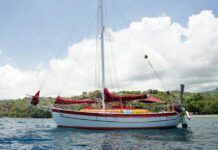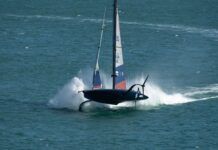Armor
-Plastic or rubber coating that protects the binocular from dents and dings, provides a sure grip, and makes them easy to clean. A must for binoculars used in the marine environment.
Coated Optics
-Microscopically thin lens coatings designed to reduce light loss and glare while increasing both sharpness and contrast. Depending on color, they can affect the color temperature of the light passing through the binoculars.
Diopter Adjustment
-A focusing ring on the eyepiece allowing the user to adjust the focus for any differences in vision between eyes. A negative diopter value signifies myopia while a positive diopter value signifies hyperopia. Binoculars with a main center focus will have a single diopter adjustment while binoculars lacking a center focus usually will have a diopter adjustment for each eye. In high-quality binoculars, the diopter adjustment is marked and accurate enough to be set to an eyeglass wearers prescription.
Exit Pupil
-The diameter, in millimeters, of the circle of light leaving the binocular eyepiece. A larger exit pupil provides a brighter image and makes the binoculars easier to use in low light and at night. The size of the exit pupil is calculated by dividing the diameter of the objective lens by the magnification. All the binos we tested have a 50-millimeter objective lens and a 7x power rating yielding a hefty 7-millimeter exit pupil. In the dark, the average adult will only have a pupil aperture of 5 to 6 millimeters. This means the binoculars are providing more light than most eyes can use, a good thing in the sometimes dark and stormy marine world.
Eye Relief
-The distance, in millimeters, the binocular eyepiece lens can be held away from the eye with the user still able to see the full field of view. Longer eye relief generally provides more comfortable viewing and is essential for eyeglass wearers.
Field of View
-The width or height of the circular viewing area seen with the binoculars. It is measured in feet at 1,000 yards. The manufacturers provided the data in our table.
Interpupillary Distance
-The distance between the centers of the pupils. The average adult interpupillary distance is 58 to 72 millimeters. The hinge between the lens tubes allows each binocular to be adjusted for various interpupillary distances.
Magnification
-The power of the binoculars. All the binos in our test are 7x, meaning they make an object appear 7 times closer than it would with the naked eye.
Objective Lens Size
-The diameter of the front lens, in millimeters. A larger objective lens allows more light
to enter the binocular and provide a brighter image. All the binos in our test
have a 50-millimeter objective lens.
Prism System
-There are two types, porro and roof. Both allow for a reduction in the overall binocular size. Traditional-looking binoculars with an offset between the objective lens and the eyepiece use the porro prism. Sleek looking binoculars with the eyepiece and objective lens in alignment use the roof prism. Porro prism binoculars are generally less expensive to manufacture, but are heavier and bulkier than comparable roof prism binos. All the units in our group use the porro prism.
Reticle
-A vertical index line that overlays the binocular image used to determine the distance of an object if the height is known.
Waterproof
-O-ring sealed binoculars capable of being submerged in 1 meter or less of water with no water intrusion or damage.






































